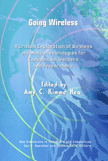Conclusions
The book finishes with an appendix written by David Menchaca entitled "Terms for Going Wireless: An Account of Wireless and Mobile Technology for Composition Teachers and Scholars," in which he argues that the conflation of the terms "wireless" and "mobile" when referring to the same technologies "conceals the histories of the technologies and closes any openings that composition teachers and researchers could use to promote alternate and potentially more productive definitions of wireless and mobile technologies" (p. 312). In other words, to conflate the two terms into one, we are limiting the potential field(s) of inquiry and critical engagement.
Menchaca also provides a history of both mobile and wireless devices in which it is clear that wireless devices have always been associated with communication, while mobile devices were originally associated with portable computation devices. Because the devices associated with these technologies have been conflated, then, so has the way we have come to think of them. And while I agree with his statement that "The way for us to assert critical agency is to recontextualize the technologies and build a new set of relations that include composition pedagogies and research methods" (p. 334), I find myself scratching my head over his conclusion that conflating the terms has anything to do with losing agency. I find myself confused over what seems to be an assumption that conflating devices and terms necessarily means that we cannot assert agency.
I admit that I could be missing something. The chapter is rather dense, after all. When he later admits, however, that
My personal predictions for wireless and mobile technologies are dark. Soon students and teachers won't meet in classrooms at all. Face to face (f2f) teaching will become a thing of the past, and learning will be something that takes place on the bus to and from anywhere but school. (p. 324)
It is here that I realize at least part of the reason why I do not understand his argument: we just do not see technology in the same way. From my perspective, though Menchaca does believe that there is possibility to assert agency—and he even goes on to give specific examples of how as they relate to specific kinds of communications technologies—his viewpoint looks to me like a kind of technological determinism. Though in Menchaca's case, his determinism is dystopian, not utopian. Nevertheless, it is still looks to me like determinism.
Still, though I disagree with his outlook, I am glad that there is a scholar out there as vigilant as Menchaca, and one who does not think there is no hope—despite the determinism with which I think he views the future of wireless in education. Perhaps it will even be his own pessimism and vigilance which will eventually justify my own more optimistic outlook on the future of wireless in the classroom. Further, the recommendations he gives for critical engagement by composition scholars resonate soundly with most of the recommendations given throughout the book, and I think his appendix is a fitting close to a book that seeks to explore a variety of viewpoints for wireless and mobile technologies in the classroom.
It is important to remember that this book seeks to be a resource. The variety of perspectives presented in the book do not make for this to be the kind of book one would sit down and read, but rather one that a teacher, scholar, administrator, or student could reference as an issue, theme, question, or situation arises. One of the volume's strongest points is that in its wide coverage, at no point does it sacrifice depth for breadth. The reader will get a healthy dose of each. While I'm not sure I would classify this volume as "essential," I would assert that as a scholarly reference it is beneficial.
